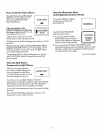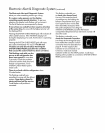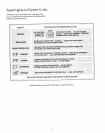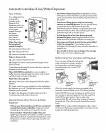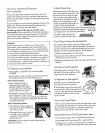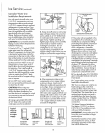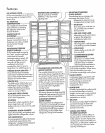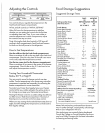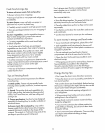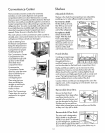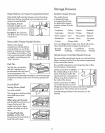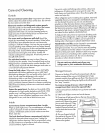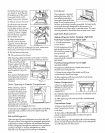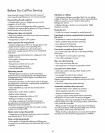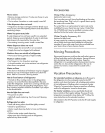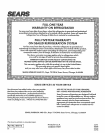
Fresh food storage tips
To store unfrozen meats, fish and poultry:
• Always remove store wrappings.
• Rewrap in foil, film or wax paperand refrigerate
immediately.
To store cheese, wrap well with wax paper or
aluminum fol), or pul in a plastic bag
• Carefully wrap to expel air and help prevent mold
o Store pre-packaged cheese in its own wrapping if
you wish
To store vegetables, use the vegetable drawers-
they've been designed to preserve the natural
moisture and freshness of produce
° Covering vegetables with a moist towel helps
maintain crispness..
• As a further aid ta freshness, pre-packaged
vegetables can be stored in their original wrapping.
To store ice cream-Fine-quality ice cream, with
high cream contenl, will normal_y require slightly
lower temperatures than more "airy" already_
packaged brands with low cream content.
o it will be necessary to experiment to determine the
freezer compartment location and temperature contrd
setting to keep your ice cream at the right
serving temperature.
o The rear of the freezer compartment isslightly
colder than the front
Tips on freezing foods
There are three essential requirements for efficient
home freezing
1. initial quality. Freeze only top-quality foods
Freezing retains quality and ftavor; it cannot improve
quality
2. Speed° The quicker fruits and vegetables are
frozen after picking, the better the frozen product
will be. You'll save time, too, with less cutling and
sorting to do.
3. Proper packaging. Use bad wraps designed
especially for freezing; they're readily available at
most food stores..
To freeze meab fish and poultry, wrap well in
freezer-weight foil (or other heavy-duty wrapping
material) forming it carefully to the shape of the
contents This expels air Fold and crimp ends of the
package to provide a good, lasting seat.
Don't refreeze meat that has completely thawed;
meat, whether raw or cooked, can be frozen
successfully only once
Forconvenience .....
° Store like things together This saves both time and
electricity because you can find foods faster
° Place the oldest items up front so they can be used
up promptly
° Use the bins on the door for most often used sauces
and condiments.
• Use the meat drawer for meats you do not freeze
To save money in energy and food costs ......
° Cover moist foods with tight lids, plastic film or foil
• Leaf vegetables and fruits placed in drawers will
last longer when stored in closed plastic containers or
wrapped in plastic film
° Do not overload your fresh food or freezer
compartment with a lot of warm bad at one timer
° Open the door the fewest times possible to save
electrical energy.
° When going out of town for several days, leave as
few perishables as possible in the refrigerator.
Move the icemaker feeler arm to the STOP (up)
position and shut off water supply to the refrigerator.
Energy-Saving Tips
• Don't open the doors more often than necessary
o Close the doors as soon as possible, particularly in
hot, humid weather
° Be sure the doors are closed tightly, Before leaving
the house or retiring for the night, check to be sure the
doors haven't been left open accidentally
° Store only those foods requiring refrigeration in
your refrigerator.
° Wipe moisture from bottles and cartons before
putting them in the refrigerator_
° Keep foods covered to reduce moisture buildup
inside the refrigerator
o If you |urn the controls to the coldest position for
quick chilling or freezing, be sure to turn them back
to regular settings.
° Don't overcrowd your refrigerator Overcrowding
can require extra electrical energy to keep
everything cool
t3



